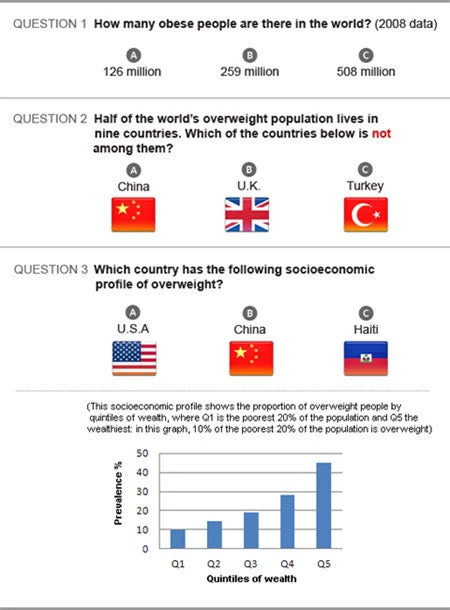Available in Español, Français, عربي
Today, we know that being overweight or obese are major risk factors for diabetes, cardiovascular diseases, hypertension, and premature death. We are constantly reminded that personal behaviors, influenced by culture and lifestyle, and our metabolic development contribute to being overweight or obese. In the March 2013 Food Price Watch, we wonder how another factor could potentially influence the world’s obesity epidemic: high food prices.
But first, let’s run a quick quiz. Many of us watch our weight routinely and may even have figured out our Body Mass Index—the ratio of body weight in kilograms by the square of body height in meters—to determine whether or not we are overweight. Yet there are some stunning facts about being overweight that you may not know.
Can you answer the questions about being overweight or obese below?
If you are surprised by some or all of these numbers, here is the most astonishing fact of all: Conservative projections predict that 2.16 billion adults will be overweight and 1.12 billion adults will be obese by 2030!1
An obvious question is how high and volatile food prices affect being overweight. The number of overweight and obese people has doubled since 1980 and accelerated since 2000, which means that the epidemic has spread during periods of both low and high food prices. But as food prices remain high and, arguably, increasingly volatile, unhealthy calories tend to be cheaper than healthy ones. This is the case of junk food in the developed world, but also of less nutritious food substitutes in poor households in developing countries coping with recurrent food (and other) crises.2 So, increasing prices of internationally traded and domestic food and/or increasing volatility augur the continuation of the overweight epidemic in the future.
Domestic policies have only partially addressed the problem. These policies range from doing nothing to punishing overweight people and promoting or compelling healthier behavior through taxes, bans, restrictive legislation on certain foods and ingredients, clearer standards for food labels, and awareness campaigns.
But preventing the global expansion of the overweight epidemic in a more prosperous world with high food prices requires integrated domestic and global collective action. Current multilateral discussions on the post-2015 Millennium Development Goals offer an unprecedented opportunity for combining global and national collective action to fight all forms of malnutrition, from stunting to obesity. Is it yet another global priority to add to the MDG to-do list?
Notes
1 T. Kelly, W. Yang, C-S. Chen, K. Reynolds, and J. He, “Global Burden of Obesity in 2005 and Projections for 2030,” International Journal of Obesity 32: 1431–37.
2 If you want to learn more about households’ coping strategies during periods of crisis, please visit the January 2012 Food Price Watch.
Answers and Sources
- C (G. Stevens, G. Singh, G. Danaei, et al., “National, Regional and Global Trends in Adult Overweight and Obesity Prevalences,” Population Health Metrics 10 [22]: 1–16 [2012]).
- B (ibid).
- C (J. Jones-Smith, P. Gordon-Larsen, A. Siddiqi, and B. Popkin, “Cross-National Comparisons of Time Trends in Overweight Inequality by Socioeconomic Status among Women Using Repeated Cross-Sectional Surveys from 37 Developing Countries, 1989–2007,” American Journal of Epidemiology 173 [6]: 667–75 [2011]).



Join the Conversation